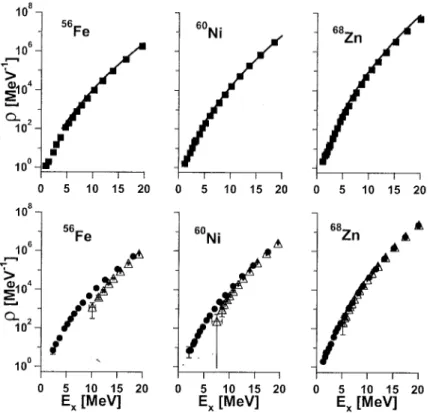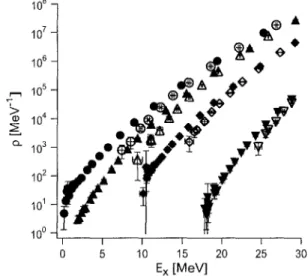ELSEVIER Nuclear Physics A7 18 (2003) 69 lc-693c
www.elsevier.com/locate/npe
Microscopic
Nuclear
Level Densities
by the Shell Model Monte
Carlo
Method
H. Nakada” and Y. Alhassidb
“Department of Physics, Chiba University, Inage, Chiba, Japan
bCenter of Theoretical Physics, Yale University, New Haven, Connecticut, U. S. ‘4. We have developed ab initio methods to calculate nuclear level densities within the shell model Monte Carlo approach. We have applied these methods to nuclei in the mass
region 50 5 A 5 70, and found remarkably good a,greement with experimental data.
Using projection methods in the Monte Carlo approach, we have also studied the parity- and isospin-dependence of level densities.
1. INTRODUCTION
accurate nuclear level densities are needed for theoretical estimates of astrophysical nuclear reaction rates, e.g., neutron capture rates in the s and T processes in nucle- osynthesis [I]. Experimental level densities are well-described by the backshifted Bethe formula if its parameters are fitted for each nucleus [a]. While the global systematics of these parameters have been studied, their actual values can have significant deviations, and consequently it is difficult to predict accurately level densities of specific nuclei.
The interacting shell model has been successful in describing properties of nuclei, in particular for the low-lying states. It is also a desirable framework to study microscopically thermal properties of nuclei, including level densities. However, such studies have not been possible in medium to heavy nuclei, as the dimensidnality of the Hamiltonian matrix is too large for conventional diagonalization methods. The recent development of the shell model Monte Carlo (SMMC) method [3] 11 a ows us to overcome this difficulty.
2. SMMC APPROACH TO NUCLEAR LEVEL DENSITIES
We have recently developed ab initio methods to calculate level densities [4] using the SMMC approach. The so-called sign problem, which often limits the applicability
of Monte Carlo calculations, was circumvented by constructing a good-sign interaction
that correctly includes the dominating collective components of realistic effective interac- tions [S]. Applying these methods to 50 5 A 5 70 nuclei in the complete (pf+0g9,2)-shell,
we found remarkably good agreement with the experimental data without any adjustable
parameters. A few examples are shown in Fig. 1. We have studied the systematics of the level density parameters that we extract from our calculations [7,S], and found that they often follow the data more closely than empirical formulas. The level densities of oclcl-even 0375-9474/03/$ - see front matter 0 2003 Elsevier Science B.V. All rights reserved.
692~ H. Nakada, Y Alhassid/Nucleav Physics A718 (2003) 691c-693~
and odd-odd nuclei were also calculated successfully despite a sign problem introduced by the projection on a.n odd number of particles [S].
lising a parity-projection methods we have also studied the parity (n) dependence of level densities [4,7,9]. For some nuclei we find significant parity dependence that has not been taken into account in nucleosynthesis ca.lcu1ation.s.
IO6 56F12 IO6 7; g104 - Q IO2 i L- i IO0 + 60Ni / 0 5 10 15 20 0 5 10 15 20 0 5 10 15 20 0 5 10 15 20 0 5 10 15 20 0 5 10 15 20 E, PWI
E, [MN
E, [MeVl
Figure 1. T&al and parity-projected level densities of “Fe, “‘Ni a.nd 6”Zn. Upper panel: SWIMC (squares) and experimental (solid lines) [6,2] total level densities. Lower panel: even- (circles) and odd-parity (open triangles) SMMC level densities.
3. ISOSPIN-PROJECTED LEVEL DENSITIES
‘The isospin quantum number T is conserved in nuclei to a good approximation. Reliable treatment of the isospin dependence of level densities could be important in 2 N AT nuclei, because the T = jTo’o/ (To = (!V - 2)/Z) and the T = /To/ + 1 levels are close in energy. However, the rela.tive energy shifts of levels with different T are not well described by the interaction we use [lO:ll]. T o overcome this problem, we have introduced an esa.ct and el-ficient T projection method in the SMMC approach, and applied it to level density
H. Nakada, Y Alhassid/Nuclear Physics A718 (2003) 69lc-693~ 693~
calculations [la]. The T-projected densities of 58Cu are presented in Fig. 2. We also find in this nucleus a significant correction to the total level density when using the T projection method to account for the proper isospin dependence of the energy levels.
IO8 - A IO7 - a” a% A 2 IO6 - d m 105- x”” s” 7 > t .g 104- 32 qP .f ‘“hA g Q 103- f 4 7y 102-f< r , f, , , 8: “I” 8 IO1 IO0 0 5 10 15 20 25 30 E, IMeVl
Figure 2. Isospin- and parity-projected SMMC level densities in “Cu. Circles; trian-
gles, diamonds and inverted triangles describe the level densities for T = 0, 1,2 and 3, respectively, and for 7r = $ (solid symbols) and x = - (open symbols).
Computations of T projection were performed on the PC cluster Helios and IBM SP3
in JAERI, and on CP-PACS in Center for Computational Physics, University of Tsukuba.
REFERENCES
1. T. Rausher, F.-K. Thielemann and K.-L. Kratz, Phys. Rev. C56 (1997) 1613.
2. W. Dilg et al., Nucl. Phys. A217 (1973) afig.
3. G. H. Lang et al., Phys. Rev. C48 (1993) 1518; Y. Alhassid et a.l., Phys. Rev. Lett. 72 (1994) 613.
4. H. Nakada a,nd Y. Alhassid, Phys. Rev. Lett. 79 (1997) 2939. 5. M. Dufour and A. P. Zuker, Phys. Rev. C54 (1996) 1641.
6. C. C. Lu, L. C. Vaz, J. R. Huizenga, Nucl. Phys. A190 (1972) 229. 7. H. Na.kada and Y. Alhassid, Phys. Lett. B436 (1998) 231.
8. Y. Alhassid, S. Liu and H. Nakada, Phys. Rev. Lett. 83 (1999) 4265. 9. Y. Alhassid et al., Phys. Rev. Lett. 54 (2000) 4313.
10. W. E. Ormand, Phys. Rev. C56 (1997) R167S. 11. Ii. Langanke, Phys. Lett. B438 (1998) 235. 12. H. Nakada and Y. Alhassid, in prepara.tion.

